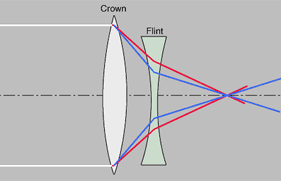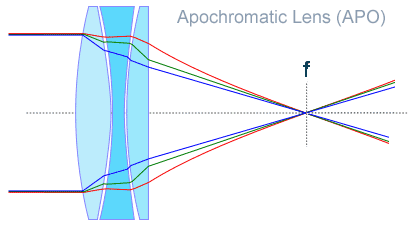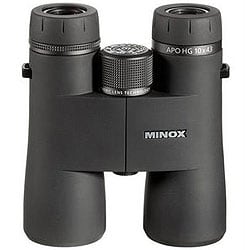Apochromatic (APO) Lenses in Binoculars
Recently I have seen as well as reviewed and tested more and more top end binoculars that use Apochromatic lenses (APO) and whilst some manufacturers mention that their products have an APO optical system, very few (if any) go on to explain exactly what it is and what it does.
So with this in mind I have decided to put together my complete guide to APO / Apochromatic Lenses in binoculars:
Why & What APO Lenses Do
When light passes through a simple single lens, the distance behind the lens at which each of the individual wavelengths of light comes into perfect focus varies. This dispersion of white light along the optical axis causes chromatic and spherical aberrations which result in you seeing soft overall images and color fringing along the edges of high-contrasting objects.

To help minimise this problem of color dispersion and spherical aberration, designers combine a number of lenses which have different optical properties and focal lengths to form a single multi-element lens, or otherwise known as a compound lens.
 Achromatic Lens
Achromatic Lens
If a compound lens is able to bring two wavelengths of light into focus in the same plane reducing these aberrations, the lens is know as an achromatic lens.
The image on the right shows a compound lens made from two lens elements, one is a convex lens made from a crown glass and the other a concave lens made from a flint glass. As you can see this achromat brings the red and blue wavelengths of light into a common focus. This achromatic combination that typically brings red and blue into focus is currently by far the most commonly used method of improving the view in binoculars at the moment.
Apochromatic Lens (APO)
If three or more visible wavelengths of light are brought into focus at the same point behind the lens, the lens is known as an apochromat or is called an apochromatic lens. APO is the abbreviation for apochromatic.

Benefits
Although they don’t have to, most apochromatic lenses consist of three elements and as as you can see from the image above, because they bring light of three different frequencies to a common focus, they have a better correction of chromatic aberration and spherical aberration than achromat lenses.
Apochromats are also corrected for spherical aberration at two wavelengths, rather than one as in an achromat.
In order for an Apochromatic lenses to focus three wavelengths of light onto the same point, they require glasses that have special light dispersion properties. This is usually means using very expensive fluoro-crown glasses, abnormal flint glasses, and even sometimes optically transparent liquids in the thin spaces between glass elements and which have highly unusual dispersive properties.
The temperature dependence of glass and liquid index of refraction and dispersion must be accounted for during apochromat design to assure good optical performance over reasonable temperature ranges with only slight re-focusing. In some cases, apochromatic designs without irregular dispersion glasses are possible.
Negatives
So we have gone over all the great things that an APO optical system can do and just how it improves your view, but what are the downsides?
- Cost – The main reason why you only find apochromats on top of the range binoculars is that because of their complexity and the use of costly materials, they add a lot to the cost of manufacturing the lenses.
- Weight – Most Apochromatic designs usually use three elements to make the lens. As we know, glass is heavy and so these triplet lenses are quite a bit heavier than the achromat doublets used on the majority of binoculars these days.
Apochromatic Triplet Lenses are as the name suggests, a compound lens with three lens elements that are designed to achieve the same focal length for three wavelengths of light.
ED Glass
Both achromatic and apochromatic lenses often contain at least one element that uses a special low-dispersion glass. For more take a look at my complete guide to Extra Low Dispersion Glass (ED Glass).
Best APO Binoculars on BBR
Listed below are binoculars that incorporate APO lenses into their system that i have tested, fully reviewed and highly recommend:
Vortex Razor UHD 10x42
 Winner of the award for Best Overall Binoculars in 2021 and then again in 2022, these Vortex binoculars are truly one of the best binoculars that I have ever used and whilst they are by no means cheap, these are certainly far less expensive than the top models from the European ‘alpha’ brands.
Winner of the award for Best Overall Binoculars in 2021 and then again in 2022, these Vortex binoculars are truly one of the best binoculars that I have ever used and whilst they are by no means cheap, these are certainly far less expensive than the top models from the European ‘alpha’ brands.
Achieving an outstanding BBR score of 92%, they got a perfect 10/10 for optical components, optical stats and image quality.
As well as their use of Apochromatic Lenses, these fantastic binos come with ED glass elements, phase corrected Abbe-Koenig roof prisms and protective outer lens coatings. indeed almost every single component used on the Razor UHD is the best that you can get.
Other highlights include a magnesium chassis, lockable diopter and a carry case that doubles as a fully enclosed bino harness. in fact, the package comes with all the necessary straps as well as an extra accessory pouch that can fit onto the front of the case or indeed anything that has the standard MOLLE webbing system.
There is no doubt in my eyes that the series of Vortex Razor binoculars really is up there with the very best.
Main Details:
- Very High-End Binoculars: Approx: – approx $1500 / £1500 / €1600
- Top Hinge Design
- Magnesium Chassis
- Water & Fogproof (Argon Filled)
- Lockable Diopter Adjuster
- XR Plus Fully Multi-Coated Optics
- APO Lens System
- ED Glass Elements
- Abbe-Koenig Roof Prisms
- Phase Corrected
- ArmorTek Exterior Lens Coatings
- Field of View: 346 @ 1000yds
- Close Focus: 4.5ft
- 16.7mm of Eye-relief
Hawke Frontier APO 10x42
 Following close on the heels of the Vortex above are these very impressive Hawke binoculars, which use the more typically used Schmidt-Pechan design of roof-prism instead of the Abbe-Koenig design.
Following close on the heels of the Vortex above are these very impressive Hawke binoculars, which use the more typically used Schmidt-Pechan design of roof-prism instead of the Abbe-Koenig design.
Whist not able to achieve the 100% of reflectivity, Hawke combat this by using the very best dielectric coatings on the prisms to get very close (more than 99% across the visible light spectrum).
This combined with the APO lens system that includes ED glass elements and a host of other features results in an image quality and brightness that is as good as you are going to see at this price level.
Another major highlight on these is the wide field of view, which for a 10x binocular is very impressive and matches that of many 8x binoculars and thus you get the best of both worlds with the Hawke Frontier APO 10x42 binoculars: more detail without an appreciable loss in the image width.
Main Details:
- Mid-High End – approx $699 / £699 / €699
- Top hinge Body Design
- Magnesium Chassis
- Fog & Waterproof
- Metal focus wheel
- Tripod Adaptable
- Optics – Hawke’s System H7
- Fully Multi-Coated
- APO Lenses with ED Glass Elements
- Phase Corrected BaK-4 Roof Prisms
- Dielectric Coatings
- Field of View: 372ft @ 1000yds
- Close Focus: 6.6ft
- 17mm of Eye-relief
Vortex 8x42 Razor HD Binoculars
 One of the main reasons I awarded these Vortex Razor binoculars the award of being the best binoculars I reviewed in 2012 was because of the fantastic quality of image they produce and definitely up there with the best I have ever seen.
One of the main reasons I awarded these Vortex Razor binoculars the award of being the best binoculars I reviewed in 2012 was because of the fantastic quality of image they produce and definitely up there with the best I have ever seen.
Note: Whilst this award was some time ago now, these binoculars have been updated and are still every bit as good as when I first tested them.
This is achieved largely due to the use of apochromatic triplet lenses, which include ED glass elements.
They also use very high quality coatings that include dielectric and phase correction coatings on the roof prisms.
Make no mistake these Vortex binoculars are very, very good and thanks to a magnesium body they have managed to keep the weight down as well, which is usually one of the main downsides to apochromatic triplet bins.
| Best Binocular Reviews Ratings: | |||||||||||||
|
Other APO Binoculars well worth checking out:
 Minox APO HG Binoculars
Minox APO HG Binoculars
Like the Vortex and Snypex binoculars above, Minox’s top-of-the-line APO HG binoculars are also optically about as good as it gets.
As well the APO lenses these have all the features you would expect to find on a binocular in this class and they use the very best SCHOTT fluoride ED-glass elements within their apochromatically-corrected lenses.
The result, according to Minox is an image completely free of color fringing.
Further reading
You can also take a look at:
- All about Extra Low Dispersion Glass (ED Glass)

 Article | Posted by Best Binocular Reviews
Article | Posted by Best Binocular Reviews 

 Categories:
Categories:  Tags:
Tags: 
